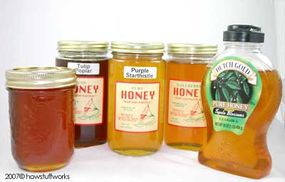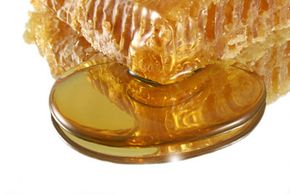Honey Production
Honey starts out as nectar that bees collect from flowers. Basically, nectar is a reward that plants produce to attract pollinating insects and birds. It's a sugary fluid includes the aromatic oils that give flowers their scent, as well as other trace substances. Bees collect this nectar by drawing it through their proboscis and storing it in their honey stomach. Honeybees then carry it back to their hive in tiny, 40-milligram loads.
The foraging bees regurgitate the nectar and pass it to worker bees in the hive. These bees then gradually transform the nectar into honey by evaporating most of the water from it. Nectar is as much as 70 percent water, while honey is only about 20 percent water. Bees get rid of the extra water by swallowing and regurgitating the nectar over and over. They also fan their wings over the filled cells of the honeycomb. This process retains lots of sugar and the plant's aromatic oils while adding enzymes from the bees' mouths.
Advertisement
The finished honey is thick, sticky and very sweet. It contains several types of sugar, including sucrose, laevulose and dextrose. Its flavor and color depend on the flowers from which the bees harvested their nectar. Orange blossom honey, for example, tastes and smells faintly of oranges.

Bees use the honey for food and store enough to survive the winter. At first glance, bees don't appear to be very active or need much food during the winter. They leave their hives only to relieve themselves, since they do not defecate in their living space. But while inside the hive, the bees are doing a lot of work. They take care of the queen and heat the hive by trembling their wing muscles, much like humans' bodies try to warm themselves through shivering. They control the temperature of the hive in summer as well, by circulating air through the hive with their wings and by sprinkling the honeycomb with water.
Honey is a good source of food for bees for two reasons. First, its high sugar content provides the bees with lots of calories, which they burn warming the nest and caring for the queen. Second, its physical properties make it extremely resistant to bacteria:
- One of the enzymes that goes into honey during nectar processing is glucose oxidase. When bees dilute honey to feed it to their young, glucose oxidase breaks glucose down into hydrogen peroxide, which helps to kill germs.
- The pH of honey is between 3.5 and 4. In other words, it's slightly acidic - about as acidic as orange juice - which discourages the growth of bacteria.
- Honey is hygroscopic, meaning that it can draw moisture its surroundings, and it has a high osmotic pressure. Bacteria that come into contact with honey undergo plasmolysis. They lose their moisture content to the surrounding honey and die.
Honey's high sugar content, flavor and antimicrobial properties make it useful to people as well. Today, it's used in home and commercial cooking, and medical research suggests that it may be effective at treating antibiotic-resistant organisms, particularly in open wounds. Neither of these is a new phenomenon -- people have been harvesting and using honey for more than 6,000 years. Historically, people have used it to sweeten food and make fermented beverages like mead. In addition, covering a wound with honey or honey-soaked bandages was a common practice before the development of antibiotics.
For these reasons, people have found ways to make it easier and more convenient to harvest honey from bees. Next, we'll look at how beekeepers provide homes for bees and harvest their honey.
